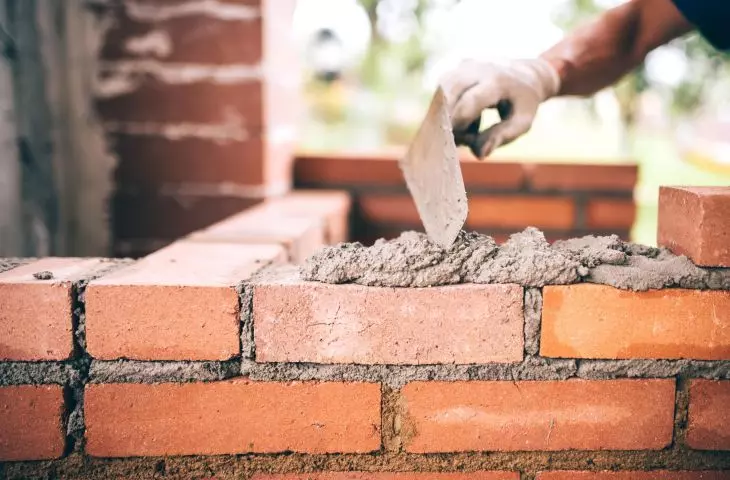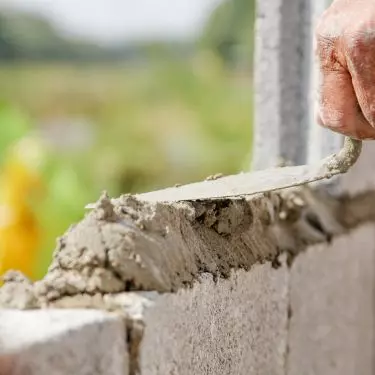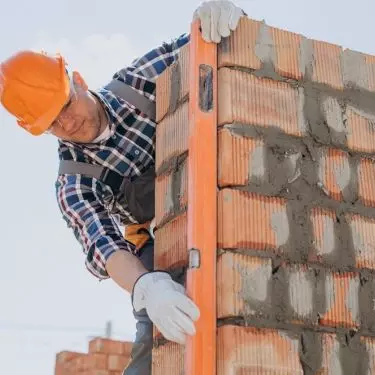The construction season is coming. One of the key elements of creating a home is bricklaying. From basic techniques and materials to practical tips, we advise on how to brick well.
The best time to brick is when the air temperature is between 5°C and 30°C
© iStock
Products for Home Guide
How to bricklay?
Bricklaying is the process of constructing buildings, walls and foundations using bricks, stones, blocks or other building materials, which are joined by mortar (usually cement) or other binding material. The process involves laying the materials in the correct order and shape, following construction standards and design guidelines. Masonry requires precision, skill and knowledge of construction techniques as well as tools.
Here are some tips to help you bricklay efficiently and effectively:
Preparation
Before starting work, make sure you have all the necessary tools, materials and a construction plan. Remove any obstacles and provide a comfortable space to work in. Proper preparation will help you avoid unnecessary downtime.
Foundations
Make sure the foundation is properly prepared for wall masonry. It should be stable and level.
Determine the baseline
Establish a baseline that will serve as a reference point for you to start masonry.
Work in moderation
Don't be in too much of a hurry, as haste can lead to mistakes. Instead, focus on precision and quality workmanship.
The right tools
Use the right tools for masonry, such as a level, trowel, hammer and mason's string. Quality tools will make the job much easier and faster.
Mix the mortar according to the instructions
Carefully follow the instructions for mixing mortar. It should have the right consistency to ensure a strong bond between bricks or blocks.
Check the walls
Make sure each brick is evenly placed and well embedded in the mortar. Regularly check the level and plumb of the wall with a level and angle iron. Ensuring evenness and straightness is key to achieving quality construction.
Be systematic
Try to avoid doing several tasks at the same time. This can lead to confusion and mistakes. Instead, lay bricks or blocks in the order and form specified by the project.
Take care of the work site
Keep the construction site clean by removing waste and unnecessary materials. Working in an orderly place is more efficient and safer.
Finish
After building the entire wall, make sure that all cracks are filled with mortar and the surface is even and smooth. Wait for the mortar to cure and reach full strength before continuing with construction work.
Brick partition walls
Partition walls do not have a load-bearing function in a building. They are used to divide space into rooms or to separate different parts of the building. Partition walls can be made, for example, from bricks, concrete blocks, etc. Partition walls can be masonry both during the construction of a new building and renovation or modernization of an existing space.
Foundation masonry
Designing
To begin with, plan the design of the foundation in accordance with construction requirements. In the design, consider the type of soil, the load on the building, and the type and depth of the foundation.
Materials
Choose the right building materials. For example, these can be concrete blocks, bricks, stones or precast concrete elements.
Preparation
Clear the area of any obstacles and vegetation. Then mark the boundaries of the foundations with masonry string and pegs to determine their exact location.
Digging
Create a trench of the correct depth and width according to the foundation design. Make sure the bottom of the trench is even and level. After excavation, create a solid and leveled base to support the foundations.
Formwork
Create formworks that will shape the foundations. They should be properly leveled and reinforced to hold the form of the foundations.
Pouring the concrete
After preparing the excavation and formwork, you can start pouring concrete. Do this gradually to avoid gaps and ensure that the excavation is filled evenly. While pouring the concrete, place reinforcement in appropriate places to strengthen the foundation and prevent cracks.
Leveling and smoothing
After pouring the concrete, use boards or a mason's batten to spread the concrete evenly and level the foundation surface.
Curing
Allow the concrete to cure properly and reach full strength before proceeding with further construction work.
For masonry, use mortar or other bonding material
© iStock
Materials for masonry
Brick
The most traditional material used for masonry. It can be used for exterior or interior walls, foundations and partitions.
Concrete blocks
This is a commonly used building material that can be used for masonry of different types of walls, foundations, or partitions.
Silicate blocks
These are lightweight, porous blocks made of mineral materials. They are used for masonry of interior and exterior walls.
Natural stone
This is a durable and aesthetically pleasing material that is often used for masonry of exterior walls, facades and fences.
Ceramic blocks
A lightweight and porous material that is often used for masonry of partitions and interior walls.
Slag concrete blocks
This type of hollow blocks is made from a mixture of metallurgical slag and cement. They are used for exterior and interior wall masonry.
Precast concrete blocks
Are often used for quick masonry of exterior and interior walls.
Composite materials
These can include plastic blocks with fiberglass additives.
Brick is the most traditional material used for masonry
© iStock
Masonry and temperature
Ambient temperature has a significant impact on the masonry process, as it can affect the properties of the mortar, the speed of setting, and the overall efficiency as well as quality of the work. The ideal air temperature for masonry is usually between about 5°C and 30°C. At temperatures below 5°C, the mortar may not cure properly, and at temperatures above 30°C it may dry too quickly, leading to a reduction in strength.
What is needed for bricklaying?
Tools
-
Trowel — for applying and spreading mortar.
-
Masonry hammer — for hammering and laying bricks or blocks.
-
Level — for checking the level of the wall.
-
Angle bar — for checking the verticality of the wall.
-
Masonry patch — for smoothing mortar.
-
Masonry string — for marking straight lines.
-
Bucket and shovel — for mixing mortar.
-
Masonry spatula — for applying mortar to bricks or blocks.
-
Rubber trowel — for smoothing and shaping mortar.
-
Carpenter 's trowel — for forging bricks or blocks.
-
Tools for cutting bricks or blocks — such as a mason's chisel and hammer.
Construction materials
-
Bricks, concrete blocks, hollow blocks or other building materials for wall construction
-
Mortar — cement, sand, water and other ingredients needed to prepare mortar.
-
Reinforcement — steel rods or mesh to reinforce the structure.
-
Insulating materials — to improve the thermal insulation of walls.
-
Grouting materials — grout or flexible fillers to finish joints.
Personal protection
-
Gloves — to protect hands from injuries and irritants.
-
Goggles — to protect eyes from dust and splinters.
-
Mask — to protect against inhalation of dust and other irritants.
Remember to wear proper personal protection while bricklaying
Photo: senivpetro © Freepik
Masonry with a laser
During masonry, you can use a laser as a measuring and leveling tool. This technique makes it possible to obtain very precise and even lines, which is crucial for achieving high quality and aesthetics. The laser should be positioned so that the light beam is evenly distributed and forms a reference line for the masonry wall.
Masonry techniques
Thin joint masonry
This technique involves laying bricks or stones on small layers of cement mortar. The joints between the pieces are very thin, which ensures the aesthetic appearance of the masonry.
Thick joint bricklaying
In this technique, the joints between bricks or stones are much thicker. This method works especially well with large, irregular stones.
Mortar adhesive masonry
Instead of traditional cement mortar, you can use adhesive, which has better properties and is easier to use.
Dry bricklaying
This technique involves laying bricks or stones without mortar. The pieces are arranged so that they hold due to their shapes and weight.
Masonry using special elements and techniques
In some cases, prefabricated masonry elements are used, such as concrete blocks or clay bricks.They are easier to use and can provide better thermal insulation. Advanced projects also use techniques such as log masonry (using wooden logs), arch masonry (creating arches with bricks or stones) or Venetian masonry (a decorative technique used mainly in Renaissance architecture).
We have more construction tips for you
Compiled by:KATARZYNA SZOSTAK































